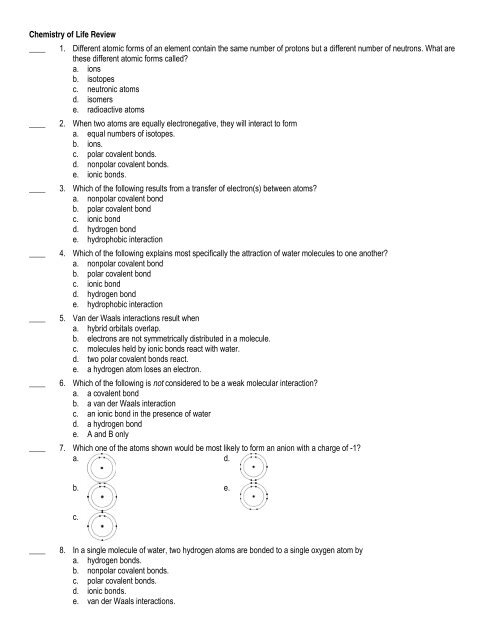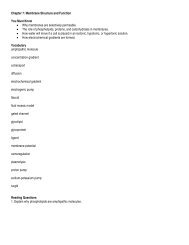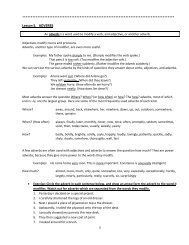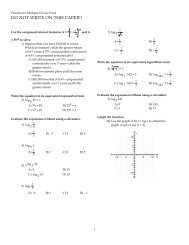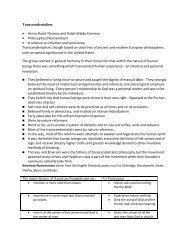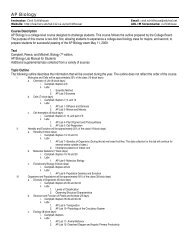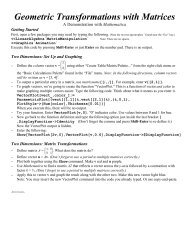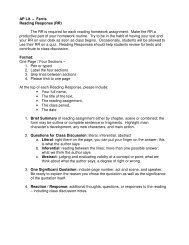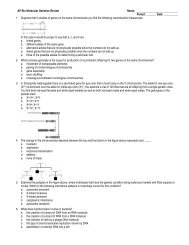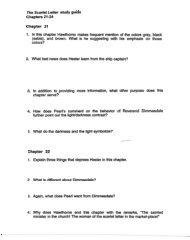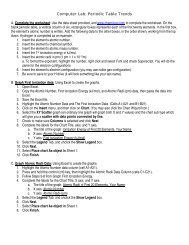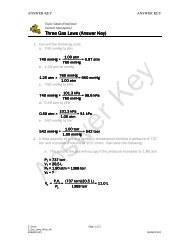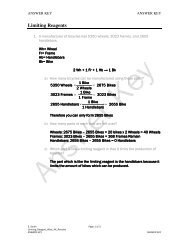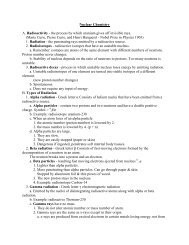Chemistry of Life Review ____ 1. Different atomic forms of ... - Teacher
Chemistry of Life Review ____ 1. Different atomic forms of ... - Teacher
Chemistry of Life Review ____ 1. Different atomic forms of ... - Teacher
You also want an ePaper? Increase the reach of your titles
YUMPU automatically turns print PDFs into web optimized ePapers that Google loves.
<strong>Chemistry</strong> <strong>of</strong> <strong>Life</strong> <strong>Review</strong><br />
____ <strong>1.</strong> <strong>Different</strong> <strong>atomic</strong> <strong>forms</strong> <strong>of</strong> an element contain the same number <strong>of</strong> protons but a different number <strong>of</strong> neutrons. What are<br />
these different <strong>atomic</strong> <strong>forms</strong> called?<br />
a. ions<br />
b. isotopes<br />
c. neutronic atoms<br />
d. isomers<br />
e. radioactive atoms<br />
____ 2. When two atoms are equally electronegative, they will interact to form<br />
a. equal numbers <strong>of</strong> isotopes.<br />
b. ions.<br />
c. polar covalent bonds.<br />
d. nonpolar covalent bonds.<br />
e. ionic bonds.<br />
____ 3. Which <strong>of</strong> the following results from a transfer <strong>of</strong> electron(s) between atoms?<br />
a. nonpolar covalent bond<br />
b. polar covalent bond<br />
c. ionic bond<br />
d. hydrogen bond<br />
e. hydrophobic interaction<br />
____ 4. Which <strong>of</strong> the following explains most specifically the attraction <strong>of</strong> water molecules to one another?<br />
a. nonpolar covalent bond<br />
b. polar covalent bond<br />
c. ionic bond<br />
d. hydrogen bond<br />
e. hydrophobic interaction<br />
____ 5. Van der Waals interactions result when<br />
a. hybrid orbitals overlap.<br />
b. electrons are not symmetrically distributed in a molecule.<br />
c. molecules held by ionic bonds react with water.<br />
d. two polar covalent bonds react.<br />
e. a hydrogen atom loses an electron.<br />
____ 6. Which <strong>of</strong> the following is not considered to be a weak molecular interaction?<br />
a. a covalent bond<br />
b. a van der Waals interaction<br />
c. an ionic bond in the presence <strong>of</strong> water<br />
d. a hydrogen bond<br />
e. A and B only<br />
____ 7. Which one <strong>of</strong> the atoms shown would be most likely to form an anion with a charge <strong>of</strong> -1?<br />
a.<br />
d.<br />
b.<br />
c.<br />
____ 8. In a single molecule <strong>of</strong> water, two hydrogen atoms are bonded to a single oxygen atom by<br />
a. hydrogen bonds.<br />
b. nonpolar covalent bonds.<br />
c. polar covalent bonds.<br />
d. ionic bonds.<br />
e. van der Waals interactions.<br />
e.
____ 9. The slight negative charge at one end <strong>of</strong> one water molecule is attracted to the slight positive charge <strong>of</strong> another water<br />
molecule. What is this attraction called?<br />
a. a covalent bond<br />
b. a hydrogen bond<br />
c. an ionic bond<br />
d. a hydrophilic bond<br />
e. a hydrophobic bond<br />
____ 10. Water's high specific heat is mainly a consequence <strong>of</strong> the<br />
a. small size <strong>of</strong> the water molecules.<br />
b. high specific heat <strong>of</strong> oxygen and hydrogen atoms.<br />
c. absorption and release <strong>of</strong> heat when hydrogen bonds break and form.<br />
d. fact that water is a poor heat conductor.<br />
e. inability <strong>of</strong> water to dissipate heat into dry air.<br />
____ 1<strong>1.</strong> Hydrophobic substances such as vegetable oil are<br />
a. nonpolar substances that repel water molecules.<br />
b. nonpolar substances that have an attraction for water molecules.<br />
c. polar substances that repel water molecules.<br />
d. polar substances that have an affinity for water.<br />
e. charged molecules that hydrogen-bond with water molecules.<br />
____ 12. Identical heat lamps are arranged to shine on identical containers <strong>of</strong> water and methanol (wood alcohol), so that each<br />
liquid absorbs the same amount <strong>of</strong> energy minute by minute. The covalent bonds <strong>of</strong> methanol molecules are non-polar,<br />
so there are no hydrogen bonds among methanol molecules. Which <strong>of</strong> the following graphs correctly describes what will<br />
happen to the temperature <strong>of</strong> the water and the methanol?<br />
a.<br />
d.<br />
b.<br />
c.<br />
e.
____ 13. One <strong>of</strong> the buffers that contribute to pH stability in human blood is carbonic acid ( ). Carbonic acid is a weak acid<br />
that dissociates into a bicarbonate ion ( ) and a hydrogen ion (H ). Thus,<br />
If the pH <strong>of</strong> the blood drops, one would expect<br />
a. a decrease in the concentration <strong>of</strong> and an increase in the concentration <strong>of</strong> .<br />
b. the concentration <strong>of</strong> hydroxide ion (OH ) to increase.<br />
c. the concentration <strong>of</strong> bicarbonate ion ( ) to increase.<br />
d. the to act as a base and remove excess H+ with the formation <strong>of</strong> .<br />
e. the to act as an acid and remove excess H+ with the formation <strong>of</strong> .<br />
____ 14. How many electron pairs does carbon share in order to complete its valence shell?<br />
a. 1<br />
b. 2<br />
c. 3<br />
d. 4<br />
e. 8<br />
____ 15. A carbon atom is most likely to form what kind <strong>of</strong> bond(s) with other atoms?<br />
a. ionic<br />
b. hydrogen<br />
c. covalent<br />
d. A and B only<br />
e. A, B, and C<br />
____ 16. Shown in the figure above are the structures <strong>of</strong> glucose and fructose. These two molecules differ in the<br />
a. number <strong>of</strong> carbon, hydrogen, and oxygen atoms<br />
b. types <strong>of</strong> carbon, hydrogen, and oxygen atoms.<br />
c. arrangement <strong>of</strong> carbon, hydrogen, and oxygen atoms.<br />
d. number <strong>of</strong> oxygen atoms joined to carbon atoms by double covalent bonds.<br />
e. answers A, B, and C<br />
Figure 4.5<br />
____ 17. Which <strong>of</strong> the structures contain(s) a carboxyl functional group? (Refer to the structures shown in Figure 4.5)<br />
a. A<br />
b. B<br />
c. C<br />
d. C and E<br />
e. none <strong>of</strong> the structures
____ 18. Which <strong>of</strong> the following is not a polymer? (Refer to the structures shown in Figure 4.5)<br />
a. glucose<br />
b. starch<br />
c. cellulose<br />
d. chitin<br />
e. DNA<br />
____ 19. How many molecules <strong>of</strong> water are needed to completely hydrolyze a polymer that is 11 monomers long?<br />
a. 12<br />
b. 11<br />
c. 10<br />
d. 9<br />
e. 8<br />
____ 20. Humans can digest starch but not cellulose because<br />
a. the monomer <strong>of</strong> starch is glucose, while the monomer <strong>of</strong> cellulose is galactose.<br />
b. humans have enzymes that can hydrolyze the beta (β) glycosidic linkages <strong>of</strong> starch but not the<br />
alpha (α) glycosidic linkages <strong>of</strong> cellulose.<br />
c. humans have enzymes that can hydrolyze the alpha (α) glycosidic linkages <strong>of</strong> starch but not the<br />
beta (β) glycosidic linkages <strong>of</strong> cellulose.<br />
d. humans harbor starch-digesting bacteria in the digestive tract.<br />
e. the monomer <strong>of</strong> starch is glucose, while the monomer <strong>of</strong> cellulose is maltose.<br />
____ 2<strong>1.</strong> What maintains the secondary structure <strong>of</strong> a protein?<br />
a. peptide bonds<br />
b. hydrogen bonds<br />
c. disulfide bonds<br />
d. ionic bonds<br />
e. phosphodiester bonds<br />
Figure 5.7<br />
____ 22. Figure 5.7 best illustrates the<br />
a. secondary structure <strong>of</strong> a polypeptide.<br />
b. tertiary structure <strong>of</strong> a polypeptide.<br />
c. quaternary structure <strong>of</strong> a protein.<br />
d. double helix structure <strong>of</strong> DNA.<br />
e. primary structure <strong>of</strong> a polysaccharide.<br />
____ 23. At which level <strong>of</strong> protein structure are interactions between the side chains (R groups) most important?<br />
a. primary<br />
b. secondary<br />
c. tertiary<br />
d. quaternary<br />
e. all <strong>of</strong> the above
____ 24. Which <strong>of</strong> the following statements about the 5' end <strong>of</strong> a polynucleotide strand <strong>of</strong> DNA is correct?<br />
a. The 5' end has a hydroxyl group attached to the number 5 carbon <strong>of</strong> ribose.<br />
b. The 5' end has a phosphate group attached to the number 5 carbon <strong>of</strong> ribose.<br />
c. The 5' end has thymine attached to the number 5 carbon <strong>of</strong> ribose.<br />
d. The 5' end has a carboxyl group attached to the number 5 carbon <strong>of</strong> ribose.<br />
e. The 5' end is the fifth position on one <strong>of</strong> the nitrogenous bases.<br />
The following questions are based on the 15 molecules illustrated in Figure 5.8. Each molecule may be used once, more<br />
than once, or not at all.<br />
____ 25. Which molecule is a saturated fatty acid?<br />
a. 1<br />
b. 5<br />
c. 6<br />
d. 8<br />
e. 9<br />
Figure 5.8<br />
____ 26. Which <strong>of</strong> the following molecules could be joined together by a peptide bond as a result <strong>of</strong> a dehydration reaction?<br />
a. 2 and 3<br />
b. 3 and 7<br />
c. 7 and 8<br />
d. 8 and 9<br />
e. 12 and 13
____ 27. Which <strong>of</strong> the following molecules consists <strong>of</strong> a hydrophilic "head" region and a hydrophobic "tail" region?<br />
a. 2<br />
b. 5<br />
c. 7<br />
d. 9<br />
e. 11<br />
____ 28. Which <strong>of</strong> the following statements is false?<br />
a. 1 and 4 could be joined together by a glycosidic linkage to form a disaccharide.<br />
b. 9 and 10 could be joined together by ester bonds to form a triacylglycerol.<br />
c. 2 and 7 could be joined together to form a short peptide.<br />
d. 2, 7, and 8 could be joined together to form a short peptide.<br />
e. 14 and 15 could be joined together to form a polypeptide.<br />
29. Construct a table that organizes the following terms, and label the columns and rows.<br />
phosphodiester linkages polypeptides monosaccharides<br />
peptide bonds triacylglycerols nucleotides<br />
glycosidic linkages polynucleotides amino acids<br />
ester linkages polysaccharides fatty acids<br />
Types <strong>of</strong> biological molecules monomers or components polymers or larger molecule type <strong>of</strong> linkage<br />
1 2 3 4 5 6 7 8 9 10 11 12 13 14 15 16 17 18 19 20 21 22 23 24 25 26 27 28<br />
B D C D B A D C B C A B D D C C E A C C B A C B E C B E


